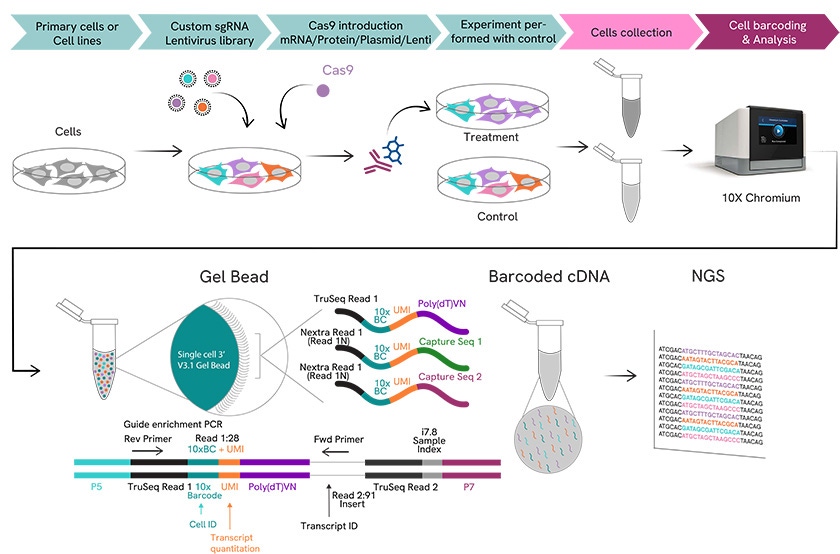
CRISPR single cell (CRISPRsc) screening combines the flexibility of pooled screening with the power of transcriptomics at single cell resolution. By linking a specific guide RNA to single cell's whole transcriptome readout, CRISPRsc offers the opportunity to interrogate the phenotype of any given genetic perturbation in great detail.
Unlocking deeper biological insights
CRISPRsc screening platform used by Revvity’s preclinical services team offers a streamlined approach to elucidating valuable biological information. One of the significant advantages of CRISPRsc screening is the possibility of analyzing datasets in more traditional pooled screening and single-cell screening paradigms for data comparison. Pooled analysis of whole transcriptome sequencing data can identify hits that are up- or down-regulated in response to a treatment and can help to verify screen performance if the treatment is known to exert a specific response e.g., change in gene expression (Figure 1).

Figure 1. Revvity’s preclinical services CRISPRsc screening workflow.
The power of pooled CRISPR screening
Pooled lentiviral screening with CRISPR-Cas9 has significantly enhanced how researchers elucidate biological pathways, identify phenotype drivers, and facilitate therapeutic discovery, evolving into a fundamental aspect of research and discovery efforts in numerous fields.
Pooled CRISPR screens offer a relatively fast, cost-effective, and precise methodology for determining the drug mechanism of action as well as identifying genetic resistance and sensitizing factors that enable patient stratification. Furthermore, they provide a straightforward method for studying gene-gene interactions and identifying critical nodes in biological pathways and processes.
The limitations of pooled CRISPR screening
Although powerful in its own right, pooled CRISPR screening is often limited to measuring a single phenotype, such as proliferation or cell survival, or simple phenotypic changes, including the measurement of changes in the activity of a single gene through the generation of a reporter cell line.
Our team has demonstrated the feasibility of coupling pooled CRISPR screening with highly complex readouts, such as single-cell gene expression profiling.1,2 It is widely acknowledged that groups of cells, even in culture, can exhibit high levels of heterogeneity, resulting in a wide range of responses within the larger population. Similarly, high levels of cell heterogeneity are also observed in cancer cell lines, leading to altered drug resistance and immune responses.
The development of a powerful hybrid approach
Understanding drug responses and treatment resistance requires investigating mechanisms at single-cell resolution. By analyzing individual cell transcriptomes following treatment, we can link gene expression signatures to drug responses, thereby facilitating biomarker discovery and the development of personalized medicine.
CRISPRsc uniquely combines the flexibility of pooled screening with the precision of single-cell transcriptomics. By connecting specific guide RNA effects to whole-transcriptome readouts, our platform reveals detailed genetic perturbation phenotypes.
Our preclinical services' CRISPRsc platform (Figure. 1) offers a streamlined approach to uncovering valuable biological insights through orthogonal analysis capabilities. Researchers can analyze data through both traditional pooled screening and advanced single-cell paradigms. While pooled analysis identifies treatment-responsive genes and validates the screen's performance, the single-cell approach reveals nuanced cellular responses that are critical for solving complex biological questions.
Whether your focus is target validation of drug therapies, analyzing cell differentiation, or another complex biological process, we're happy to discuss how this approach can take your research to the next level. Contact us to schedule a consultation today.
References
le Sage C, Lawo S, Panicker P, et al. Dual direction CRISPR transcriptional regulation screening uncovers gene networks driving drug resistance. Sci Rep. 2017;7(1):17693. doi:10.1038/s41598-017-18172-6.
Blanck, Maximilian et al. “A Flexible, Pooled CRISPR Library for Drug Development Screens.” The CRISPR journal vol. 3,3 (2020): 211-222. doi:10.1089/crispr.2019.0066
For research use only. Not for use in diagnostic procedures.


































